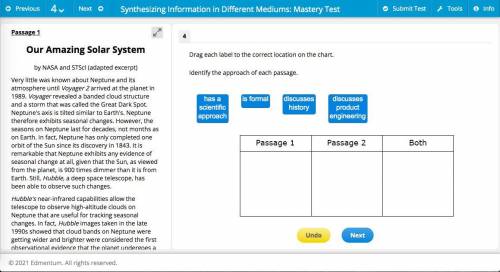Drag each label to the correct location on the chart.
Identify the approach of each passage.
...

English, 08.10.2021 19:10, jennemylesp19oy5
Drag each label to the correct location on the chart.
Identify the approach of each passage.
- has a scientific approach
- is formal
- discusses history
- discusses product engineering
Passage 1
Our Amazing Solar System
by NASA and STScI (adapted excerpt)
Very little was known about Neptune and its atmosphere until Voyager 2 arrived at the planet in 1989. Voyager revealed a banded cloud structure and a storm that was called the Great Dark Spot. Neptune's axis is tilted similar to Earth's. Neptune therefore exhibits seasonal changes. However, the seasons on Neptune last for decades, not months as on Earth. In fact, Neptune has only completed one orbit of the Sun since its discovery in 1843. It is remarkable that Neptune exhibits any evidence of seasonal change at all, given that the Sun, as viewed from the planet, is 900 times dimmer than it is from Earth. Still, Hubble, a deep space telescope, has been able to observe such changes.
Hubble's near-infrared capabilities allow the telescope to observe high-altitude clouds on Neptune that are useful for tracking seasonal changes. In fact, Hubble images taken in the late 1990s showed that cloud bands on Neptune were getting wider and brighter were considered the first observational evidence that the planet undergoes a change of seasons.
In 2002, astronomers using Hubble noted that the abundance of high-altitude clouds increased the planet's brightness from observations made in the late 1990s. Astronomers consider this brightness increase a sign of seasonal change. Hubble studies show that Neptune has a nearly constant brightness at low latitudes (near the equator). This supports the idea that the observed changes are seasonal in nature, because seasonal effects would be minimal near the equator and most evident at high latitudes.
Passage 2
About the Hubble Space Telescope
by NASA and STScI (excerpt)
Orbiting 360 miles above Earth, the Hubble Space Telescope is positioned high above the blurring effects of the atmosphere. From this vantage point, it captures images with 10 times the typical clarity of any ground-based telescope and views not only visible light, but also wavelengths1 of near-infrared and ultraviolet light that cannot reach Earth's surface. To operate from orbit, the observatory works like any other scientific or imaging spacecraft; it converts the optical data it collects into electrical signals that are transmitted back to Earth. It must also withstand the airless, high-radiation, and harsh thermal environment of space.
Unlike most other spacecraft, however, Hubble was designed to be serviced periodically by astronauts and so was built with modular components that are astronaut-friendly to handle and replace. This design strategy has enabled it to operate longer than ordinary spacecraft and to benefit from the technological advancements of the last two decades. Astronauts have visited the telescope five times to upgrade its computers, mechanisms, and instruments. These servicing missions have kept the observatory at the forefront of discovery by providing it with increasingly sensitive and accurate components. The last of these servicing calls was in May 2009.
1. the distance between one light wave from any one point to the next point of corresponding phase


Answers: 1
Other questions on the subject: English

English, 22.06.2019 05:00, kellynadine02
What do the sketches of 9/11 victims in "portraits of grief" achieve?
Answers: 1

English, 22.06.2019 18:00, isabellamason5900
Based on hale’s comment, what can you infer was a common attitude during the time of trifles? check all of the boxes that apply. women’s thoughts are not considered to be as important as men’s. it is normal for men to make generalizations about all women. women are the ones who notice important details. women take care of details that are less important than those that concern men.
Answers: 3


English, 22.06.2019 23:00, hipposaresofluffy
Conjugate latin and english in three tenses, present, imperfect and future. in this format: singular plural 1st 2nd 3rd moveo, movere, movi, motus - move
Answers: 1
Do you know the correct answer?
Questions in other subjects:


Biology, 30.10.2020 16:50




History, 30.10.2020 16:50









